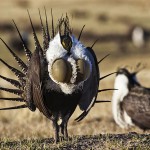
On Tuesday, September 22, 2015, the Sage Grouse was denied protection under the Endangered Species Act of 1973 (ESA).
I was following the story as an avid birder. Posting my reaction here on our blog was delayed because I was involved with managing the World Rhino Day Facebook page, Twitter feed and website. I was very happy with level of global participation and celebration on World Rhino Day.
But the Sage Grouse decision has left a bittersweet taste in my mouth.
In truth, the decision was not a big surprise. At the turn of the century, the Sage Grouse was under attack from the Bush White House and its Department of Interior.1 The Sage Grouse had developed a long list of powerful enemies over a vast range of 11 states.2 Additionally, a report from the United States Department of Agriculture claimed that some regional Sage Grouse populations were growing.3 The report seemed to support the ESA listing opposition’s claim that regional conservation efforts were enough and that ESA listing was unnecessary. Although regional success is commendable, it will take decades to determine the long term success of these programs.
At the end of the day, there is one certain fact: Sage Grouse populations that once numbered in the millions are now in the hundreds of thousands.
That number may seem high, but as the habitat of the Big Empty erodes, the population will almost certainly go lower.
So who was behind the Sage Grouse’s defeat? Was it the U.S. Military? Perhaps it was cattle ranchers or farmers across 11 states in search of more pasture and crop acres. Maybe it was the miners. This industrial sector has ravaged the Sage Grouse’s lands for decades. All of these parties do indeed receive some of the “credit”. The main culprit, however, appears to be big oil.
The Western Energy Alliance, a major oil lobbyist, seems to be at the center of mobilizing forces against the Sage Grouse. The Alliance launched a massive online and radio campaign against the Sage Grouse ESA listing. They were not shy about it. The campaign claimed that the bird’s ESA listing would halt U.S. economic growth and threaten the “western way of life”. The media release can be found here.
Western Energy Alliance has launched an ad campaign to educate westerners on how a listing of the Greater Sage-Grouse under the Endangered Species Act (ESA) would discourage effective local and state conservation efforts while stifling economic growth and job creation. The three-part video series contrasts collaborative, state-led conservation with misguided environmental activism and a one-size-fits-all federal approach.
The deep-pocketed Western Energy Alliance and its members were also active in lobbying Congress.4
Many opponents to the Sage Grouse ESA listing received contributions and other motivation to vote for legislation in favor of economic development.
The final victory was determined in Washington.
What will happen to the Sage Grouse now that the industrial complex has won a huge victory over conservationists? It seems that the impetus of the fight was over economic expansion, increased development, and oil and gas exploration. However, global growth is slowing. Oil and commodity prices are at multi-year lows, while demand from China and the emerging world has evaporated. Surely there is less need for expansion with a glut of supply on the global market. But don’t count on it.
The Western Energy Alliance members list is a Who’s Who of battered stock prices on Wall Street.5 Some of these companies show up at environmental controversies the same way the Jack Torrance character appears in every staff photo of Stanley Kubrick’s The Shining. These corporations need to continue to expand in order to satisfy shareholders and pay dividends. Some weaker companies will be taken over, but the survivors will continue to expand. Expansion is needed to maintain share in the global marketplace. Companies will seek to compete with most cost-efficient, stable strategies. Right now, no business environment is more stable than the United States of America.
The Sage Grouse will continue its battle against fragmented and eroded habitat. Regional measures will continue serve as its champion. We must place our support with these efforts. They might be enough. National Audubon Society President and CEO, David Yarnold states, “This is a new lease on life for the Greater Sage-Grouse and the entire sagebrush ecosystem.”6
Unprecedented cooperation by private landowners, states, and the federal government has created a framework for conservation at a scale unique in the world.
“Unprecedented cooperation” will be required indeed. The optimist is hopeful, but the cynic is skeptical. There will be successes, but there will also be many loopholes for corporations and private interests to exploit. Some pristine lands will be preserved, but what will be done about the unprotected lands? Who will restore habitat that has already been destroyed by pollution? Will it be too late for the Sage Grouse when it comes up again for ESA listing review?
There seems to be almost as many questions about the Sage Grouse’s survival as there are about U.S. economy. That’s not good for anybody. At the end of the day, the tie always seems to go to the economic interests.
1. http://www.thenation.com/article/did-the-fish-and-wildlife-service-just-doom-this-bird-to-extinction/
2. https://annamiticus.com/2015/08/21/american-commerce-is-no-friend-of-protected-birds/
3. http://blogs.usda.gov/2015/08/17/greater-sage-grouse-population-on-the-rise/
4. http://www.thenation.com/article/did-the-fish-and-wildlife-service-just-doom-this-bird-to-extinction/
5. http://www.westernenergyalliance.org/alliance/our-members
6. https://www.audubon.org/news/unprecedented-conservation-efforts-keep-greater-sage-grouse-endangered-species




